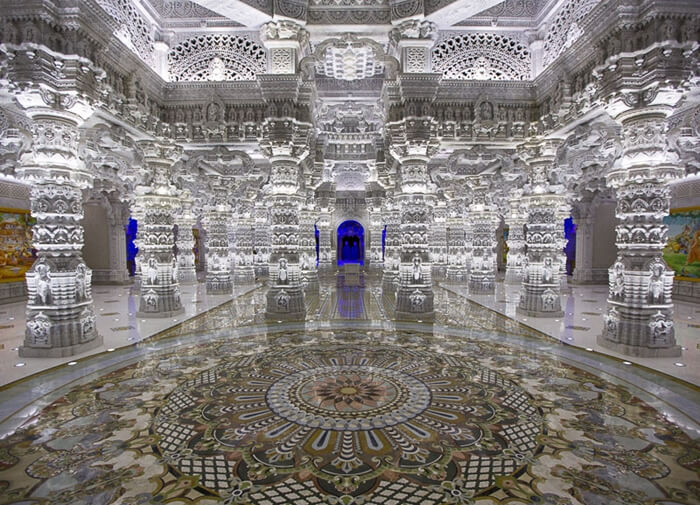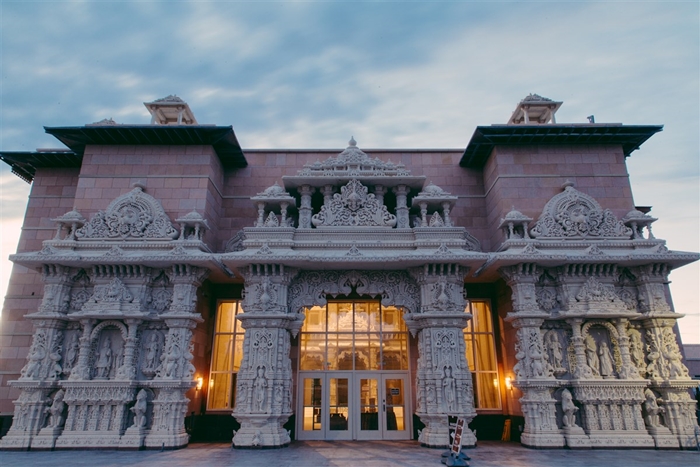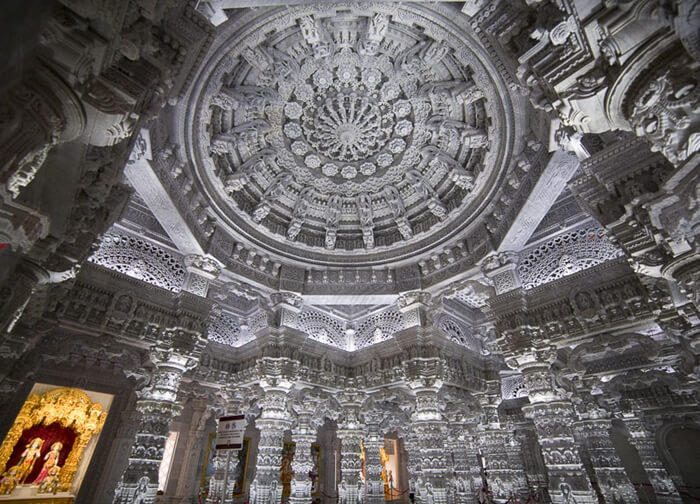Hundreds of thousands of Indian immigrants’ spiritual heritage and deep-rooted divine faith have finally taken shape as America’s largest Hindu temple, BAPS Akshardham Mandir in New Jersey. After 12 long years of intensive construction in five phases, BAPS Shri Swaminarayan Temple of Robbinsville NJ will be ceremonially inaugurated on October 8 under the auspices of Mahant Swami Maharaj and in the presence of prominent Indian American community leaders. However, the temple will welcome visitors from October 18, the fourth day of Navaratri 2023.
Sprawling across over 180 acres in Robbinsville, BAPS Swaminarayan Akshardham Mandir is said to be next to Cambodia’s Angkor Wat Temple Complex in size and area. It may continue to be the world’s second largest temple until the Mayapur Temple of Vedic Planetarium is inaugurated in 2024. Incepted in 2010 under the supervision of Pramukh Swami Maharaj, the New Jersey Indian temple, though incomplete then, opened its door to devotees first in 2014.

PC: BAPS.org
The making of BAPS Swaminarayan Temple Robbinsville was a marathon spanning 12 years and involving nearly 13,000 volunteers from across the USA. The monumental construction thousands of miles away from India was a multifaced process that ran from Europe to India to the US. Made of chiseled Italian marbles sourced from different parts of Europe and hand-carved in Rajasthan, the temple is bigger and higher than the Akshardham Mandir in New Delhi.
One of the interesting facts about the world’s largest Akshardham Temple in New Jersey is that as many as 2000 craftsmen in Rajasthan hand-carved the marble stones from Europe into beautiful pieces of art with chisels and hammers; the pieces were assembled twice. The marble pieces were assembled in India first to check if they would fit accurately and then, they were subsequently numbered. They were finally organized and assembled in the US, according to their numbers.
Undeniably, it was quite challenging to transport the two million cubic feet of marble stones 21,500 miles from Europe to India and then to America.
Needless to say, the temple is an aesthetically wonderful edifice both outside and inside in its complete form. It is encased with a colossal mandap for external protection. The 135-ft wide mandap with delicate engravings on the pillars stands 55 feet tall. The main gate of the mandap, called Mayur Dwar, is a major attraction of the temple. Robbinsville Swaminarayan Temple’s Mayur Dwar is meticulously adorned with 236 sculptures, including peacocks, elephants, monks and devotees carved out of marble.

Mayur Dwar (PC: BAPS.org)
“The sculptural beauty of the Mayur Dwar will leave you in awe of the artisans who achieved this rare feat in the 21st century. It captures the cultural zeitgeist of the pre-Sultanate era when the Dravidian temple architecture known for intricate designs and intensive wall carvings had flourished,” said Sourav Agarwal, the Editor of Travel Beats, a one-stop community portals for Indians in America.
The mandap comprises a grand prayer hall which is spacious enough to accommodate more than 1000 people at a time. Among the breathtaking features of New Jersey’s BAPS Akshardham Mandir are two heavily ornate domes, unique to India’s traditional stone architecture, which are designed to last a thousand years. There are one main shrine, 12 sub-shrines, 9 shikhars, and 9 pyramidal shikhars in the temple complex.
Every bit of the United Sates’ largest BAPS Swaminarayan Temple design is eloquent enough to tell a story. A whopping 10,000 sculptures and figurines of India’s age-old musical instruments, classical dance forms, and epic characters on pillars, panels, walls and ceilings depict stories of ancient Bharat and the Hindu scriptures. The prayer halls are dotted with life-size idols of saints and sages among India’s spiritual leaders.
An interface between the architectural styles of north and south Indian temples, the Akshardham Mandir of Robbinsville NJ houses a world-class research institute. Inaugurated in June 2022, the institute is “the first such center of learning and research of Indian languages and Hindu scriptures in the Swaminarayan tradition in the United States”, with the goal of promoting the highest level of academic excellence in all disciplines of study. The other facilities available within the temple complex include a rest house, a food court, and a visitors’ center housing exhibits related to Indian culture as well as history.

Ornate dome in the ceiling of the grand prayer hall (PC: BAPS.org)
Like many ancient temples across India, the Swaminarayan Akshardham Mandir has Brahma Kund (a sacred stepwell) at its Robbinsville site in the northeast US. Interestingly, the water of the kund has been collected from more than 300 natural sources of water from around the world, including the holy rivers of India and the water bodies in 50 US states.
A one hour drive from Newark, this largest Hindu temple in the US would not have become a reality without the craftsmen and 13000 volunteers of all ages, who generously spent 5 million man hours on making such a complex, colossal masterpiece. Indians from New Jersey and other states came forward to devote their time in all possible ways, including preparing food for the artisans, cleaning up the construction site, etc. Evidently, the temple is an emblem of oneness and harmony among them. On completion of the construction, the total cost of Robbinsville BAPS Swaminarayan Akshardham Temple, New Jersey may have gone up to more than $150 million.
This article is a part of the series – Hidden Gems of America – by Indian Eagle, a most trusted travel-booking partner of Indians in the USA. Travel Beats, a subsidiary of Indian Eagle, is a one-stop portal for stories of Indian immigrants, US-India travel news, and US visa & immigration updates.







